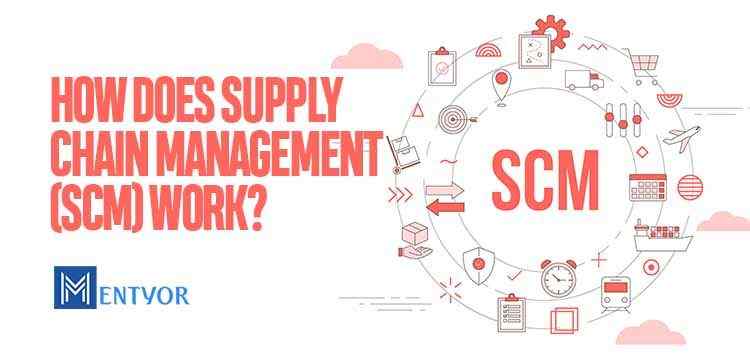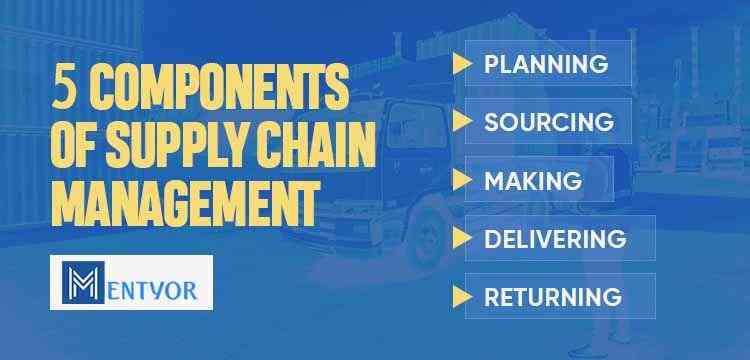In the world of business, managing expenses and delivering quality products to customers is the key to growth. Great companies who achieved success, name, and fame within no time have transparency and customer satisfaction in every step. Thus, the successor business of a company ultimately depends on its supply chain. It forms a link between the goals of the company and the satisfaction of the customers. Thus, supply chain management (SCM) has become essential to prosperity for almost every company.
What Does Supply Chain Management Mean?
The supply chain of any business describes a financial layout of the processes involved in manufacturing services and goods, starting from the supply of raw materials. Companies and businesses have constant improvements in their supply chain because it detects the loopholes of their business, thereby helping them cut down some extra expenses and deliver better quality products to the customer in less time.
Thus, SCM (Supply Chain Management) refers to the management of all supply chain activities. Supply chain activities include product lifecycle management, procurement, planning of supply chains, and logistics. Thus, logistics is a part of SCM. SCM is a much wider concept which includes every business function of the company. The history of the term SCM dates back to 1982, when Keith Oliver used it for the first time in an interview. However, it began to be used extensively during the late 1990s.
You may also like to read:
- WHAT IS AMAZON MARKETING STRATEGY
- PORTER’S FIVE FORCES
- COCA COLA MARKETING STRATEGY
- PEPSI MARKETING STRATEGY
- GUCCI MARKETING STRATEGY
Every single service which gets disposed of to the customer’s needs represents the company or business as a whole. This includes the combined efforts of all the organisations and subunits present in the business. Moreover, companies and businesses mainly remain constricted to the management of activities that happen within the four walls of the industry. But, with the evolution of the concept of SCM, the company looks into its business from all the possible spheres, which ensures transparency in services delivered to the customer.
Thus, supply chain management aims to ensure and boost customer values and gain healthy profits simultaneously. The activities included in the supply chain range from sourcing and development of raw materials to logistics. The organisations or subunits of the supply chain are connected together due to the flow of goods and information. The flow of materials and goods between organisations is referred to as physical flows. Whereas the flow of information, including long-term plans, is referred to as information flows.
How Does Supply Chain Management (SCM) Work?

The main tasks of the supply chain can be classified into three categories: information, finances, and products. Information flow includes transferring information, order purchases, sales, product delivery, and others. Product flow includes timely manufacturing and delivery of all the products to their desired customer destination. Finances flow includes payments, billing, and other finances.
All these three categories are linked to each other. One of them can not be balanced without the other. Whereas when one of them is balanced, the other one gets balanced automatically. Thus, SCM is laid on the basis of the proper and efficient functioning of these three flows. Source : ( Investopedia )
5 Components Of Supply Chain Management

The integration of all processes of management of demand and supply ranging from those taking place within the organization to other members of the business refers to as the management of the supply chain. Every supply chain management includes five basic components, namely;
- Planning
- Sourcing
- Making
- Delivering
- Returning
Planning
In order to complete the demands of the customer, the company and business heads need to discuss and forecast it first. It will help them in estimating the supply chain, which will further assist them in determining the methods to boost efficiency at every step. Thus, proper planning forms the first step of supply chain management.
Sourcing
The second step of SCM, i.e., sourcing, involves the strategic planning and management of suppliers who manage the entire ecosystem. This includes suppliers who supply raw materials to those who are involved in the processing of raw materials. Sourcing includes management of order placements, receivals, and payment.
Making
Making involves the coordination between other members of the supply chain who manage further steps after the creation of the product. These coordinating members’ duties include reviewing the quality of raw materials and the final product. Packaging and quality testing are the most vital steps.
Delivering
Logistics is the main part dealing with the timely and safe delivery of products to the customer. Logistics manage various functions starting from coordination, organisation, and dispatch of orders, preparing invoices, and collecting payments. It’s the choice of the business either to have its own delivery medium or to outsource it to any other logistic company.
Returning
The situations of return products are common in any business. The reasons may vary from customer to customer. Supply chain managers should be conscious of developing and managing a proper logistic network for pickups and returns. This organisation needs to be too cautious and flexible to the customer’s demands.
Examples Of Supply Chain Management
Examples of well-established companies with a well-managed ecosystem of supply chains are many. Let’s discuss some such shining companies.
The Coca-Cola Company
Coca-Cola forms the basis of distributors and marketers dealing in non-alcoholic drinks. With their headquarters located in Atlanta, GA, they have made their products available virtually in almost all corners of the world. According to a segmentation strategy, their customer bandwidth aligns well with their supply chains. Despite owning this global level player, the brand still indulges in partnerships and other such programs where it effectively markets its products.
Amazon
With its headquarters in Seattle, Washington, Amazon has made itself the largest and top ranking one in the list of US internet-based retailers. Amazon has expanded its product base beyond limits, from books to literally everything. The main reason behind the success of Amazon is they aren’t limited to physical stores. Their logistics and supply chain helps them take the responsibility of shipping about 10 million products, thereby contributing to their success story.
Colgate
Colgate has been the chief toothpaste brand dominating the oral hygiene scenario since the last half of the 19th century. With the help of a proper distribution channel and product diversity, Colgate is able to manage its place in the market. From pharmacies to wholesalers, one can find Colgate toothpaste in almost every shop. This explains the diversification of their products which contributes to their effective SCM and logistics.
Suggested Blogs:
- LOUIS VUITTON MARKETING STRATEGY
- BURGER KING MARKETING STRATEGY
- AIRBNB MARKETING STRATEGY
- SAMSUNG MARKETING STRATEGY
- VIVO MARKETING STRATEGY
Advantages Of Supply Chain Management

Looking from a global perspective, the supply chains have become too complex in the modern era. This complexity counts to the data-driven approach, which makes information and goods flow transparent from one end to the other. Supply chain management has many benefits.
Improves Collaboration
Oracle states that about 76% of businesses and companies don’t have automation in the information flows. Moreover, companies acquire half pr fragments of information, which leads to a loss in sales. But, with supply chain management, both information and physical flows are well managed to make transparency a keep point.
Improvement In Efficiency
Generally, companies don’t have real-time updates regarding the availability of raw materials and other processes of the manufacturing process. Thus, they have no backup plans for emergencies, due to which they fail to face problems such as delayed shipping and others. However, with SCM, this situation is elevated. The lack of these unforeseen circumstances improves the reputation of the company and the customer’s positive experience.
Improves Quality Of Products
The Rule of 10, which speaks about quality control issues, states that during the crisis of quality issues, the amount spent in replacement or exchange of any product increases at the rate of ten times at each level. Thus, it becomes essential for companies to have improved control and authority over their direct and indirect suppliers.
With the implementation of supply chain management, the quality of products increases right from the initial step of raw materials. The quality of products is assessed from the very initial to the final step. Moreover, on-time delivery of the best quality of products is assured. It, in turn, reduces the cases of complaints.
Reduction In Overhead Expenses
When a company has its estimates about the demand, the overhead expenses automatically get reduced. Warehouse fulfilment costs, which form a major part of overhead expenses, get reduced. Only quality products of the appropriate amount are produced in a fixed and proper time span. Thus, the efficiency of organisations and quality of products get elevated, leading to lower overhead expenses.
Final Takeaway
Moreover, there are other benefits of the implementation of supply chain management in a business. SCM can reduce shipping costs due to the identification of affordable and efficient shipping logistics for various kinds of orders. Besides shipping optimization, SCM also helps in reducing the chances of risks because companies know the risks of their supply chain ecosystem beforehand to prepare for the backup plan. Ultimately, SCM leads to improvement in cash flow to proper directions and satisfaction of the customers.


 WhatsApp
WhatsApp